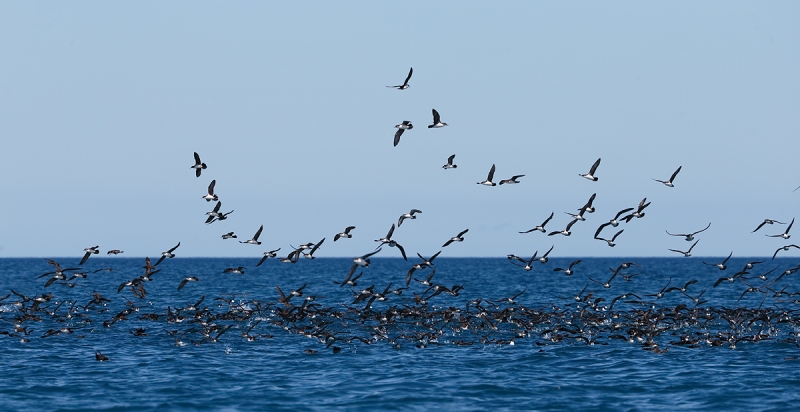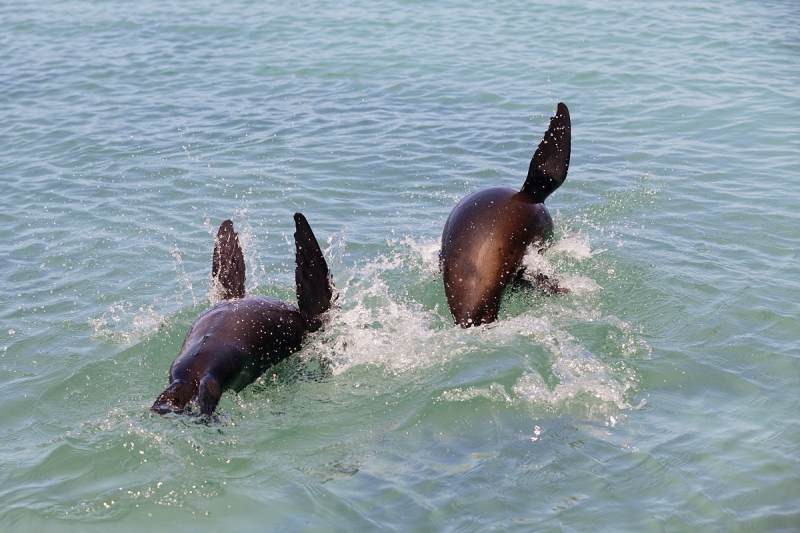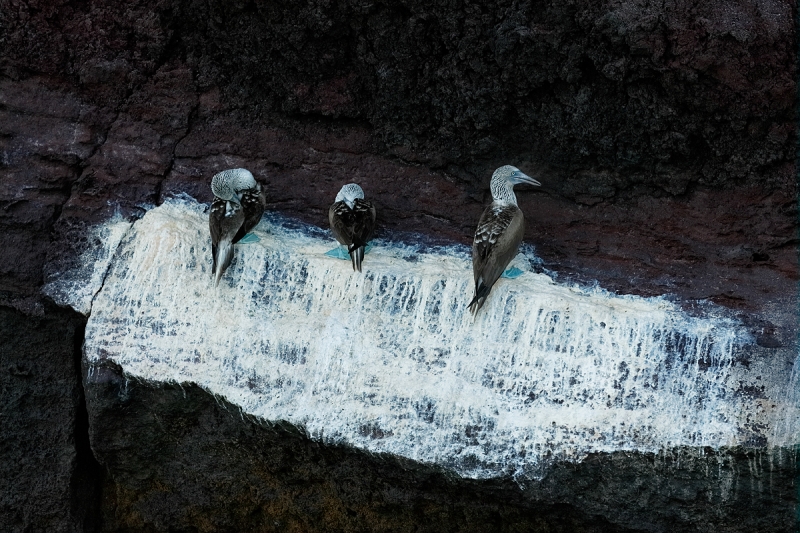Day 6 Mid-morning Panga Ride: Elizabeth Bay, Isabela
|
This image was created with the hand held Canon EF 200-400mm f/4L IS USM Lens with Internal 1.4x Extender (270mm) and the Canon EOS-1D X. ISO 400. Evaluative metering -+1/3 stop: 1/2500 sec. at f/6.3 in Av mode. Three sensors below the central sensor/AI Servo-Surround/Rear Focus AF on the flock in the water active at the moment of exposure. Click here if you missed the Rear Focus Tutorial. Click on the image to see a larger version. |
Cloudy Bright Rocks/But Not on this Panga Ride!
After our early morning zodiac photo session at Punta Mangle, Fernandina, we did a short navigation across the Bolivar Channel to Elizabeth Bay, Santiago and enjoyed a late breakfast en route. One of the huge benefits of visiting the Galapagos from mid-June through August is that the weather is usually overcast during that period; nothing kills good nature photography in tropical regions faster than blue skies and clear, sunny days. We did enjoy some beautiful light in the early morning and late afternoon hours but for the most part we enjoyed the cloudy bright conditions that make photographing all day long a pleasure. On my photo-cruise two years ago we suffered from way too much sun and many of our morning landings were over by 9:30am.
In any case, the sun was out pretty strong when we did our panga cruise at Elizabeth Bay; this made photography extremely challenging. The image above of a large Galapagos Shearwater feeding aggregation was created in bright sun. We made sure to position the zodiac so that the birds were right down sun angle, in other words, so that our shadows were pointed directly at the spree.
|
These frolicking sea lions were photographed with the hand held Canon EF 70-200mm f/2.8L IS II lens (at 80mm) and the Canon EOS-1D X). ISO 800. Evaluative metering +2/3 stop: 1/1000 sec. at f/5.6 in Tv mode. Three sensors down from the central sensor/AI Servo Surround/Rear Focus AF just caught the flipper of the left hand sea lion and was of course active at the moment of exposure. Click here if you missed the Rear Focus Tutorial. Be sure to click on the image to see a larger version. |
Still Room at the Inn for the 70-200II
While the hand held Canon EF 200-400mm f/4L IS USM Lens with Internal 1.4x Extender turned out to be my favorite and deadliest lens for zodiac photography there was still lots of room at the inn for the relatively old 70-200mm f/2.8 L IS II lens. When I needed to work wider than 200mm I went to my dependably sharp intermediate telephoto lens; the versatile 70-200 II is one of my all-time favorite lenses and is a perfect companion for the 200-400 for zodiac and general nature photography.
|
This image was created with the hand held Canon EF 70-200mm f/2.8L IS II lens (at 165mm) and the Canon EOS-1D X). ISO 400. Evaluative metering at zero: 1/800 sec. at f/4 in Manual mode. Two sensors above and two to the left of the central sensor/AI Servo Surround/Rear Focus AF on the wall between the two birds on our left active at the moment of exposure. Click here if you missed the Rear Focus Tutorial. Be sure to click on the image to see a larger version. |
AI Servo AF Active at the Moment of Exposure
Sharp-eyed readers will note that the each and every one of the images made from a zodiac was created with AI Servo AF active at the moment of exposure. Why? Because the boat is always moving; the only way to achieve accurate focus is to use AI Servo AF. If you attempt to use One-Shot AF (S or Single Servo in Nikon) none of your images will be sharp; accurate focus will always be thrown off. Studious readers have heard the same tune from me often when it comes to hand holding even when you are on land. With intermediate and super-telephoto lenses the swaying motion of your body and even your breathing will be enough to prevent you from making the sharp images that you want if you insist on using One-Shot AF.
In the image above, I replaced the head of the bird on our right (poor head angle) with the head of the same bird from the previous frame (perfect head angle). To do this I painted a Quick Mask of the bird’s head, put it on its own layer (Q, B, Q, Control J), and moved it (V) into the image I was optimizing. I fine-tuned the replacement head with a Regular Layer Mask.
The Best Image?
Which of the 3 images above do you like best? Do let us know why.
Bucket List?
If visiting the Galapagos is on your bucket list and you are a happy camper who is serious about joining us on our July 2015 trip, please shoot me an e-mail and ask to be placed on the interested list. There simply is no better Galapagos Photo Tour.
On The Road Again
Please know that I will be traveling to and from the Africa for the Tanzania Photo Safari with Todd Gustafson leaving today, August 1 and back in the office on August 21. I will have extremely limited and very slow at best internet access so please do not e-mail me until I get back. Jim will be in the office every weekday to help you with your mail order purchases and Jen will be here handling IPT registrations. The blog will continue to be active as I have prepared a dozen interesting, brand new educational posts for you in advance for you to enjoy during my absence.
Please consider using our B&H, Amazon, and Borrow Lenses affiliate links for all of your major and minor purchases both photographic and household. If we carry something in the BAA Store that you need our very great preference would be that you purchase those items from us :).
If you have a gear, image processing, or other question please e-mail me after July 19th. You can reach Jim here via e-mail. You can reach Jennifer here via e-mail. Please type “JIM” or “JEN” respectively at the front of the Subject Line.
Typos
On all blog posts, feel free to e-mail or leave a comment regarding any typos, wrong words, misspellings, omissions, or grammatical errors. Just be right. 🙂
Support the BAA Blog. Support the BAA Bulletins: Shop B&H here!
We want and need to keep providing you with the latest free information, photography and Photoshop lessons, and all manner of related information. Show your appreciation by making your purchases immediately after clicking on any of our B&H or Amazon Affiliate links in this blog post. Remember, B&H ain’t just photography!




Support the Blog


Amazon
Everyone buys something from Amazon, be it a big lens or deodorant. Support the blog by starting your search by typing in the little white box below. No purchase is too small to be appreciated; they all add up. Why make it a habit? Because I make it a habit of bringing you new images and information on an almost daily basis.
And from the BAA On-line Store:
LensCoats. I have a LensCoat on each of my big lenses to protect them from nicks and thus increase their re-sales value. All my big lens LensCoat stuff is in Hardwood Snow pattern.
LegCoat Tripod Leg Covers. I have four tripods active and each has a Hardwood Snow LegCoat on it to help prevent further damage to my tender shoulders 🙂 And you will love them in mega-cold weather….
Gitzo GT3532 LS CF Tripod. This one replaces the GT3530LS Tripod and will last you a lifetime. Learn more about this great tripod here.
Mongoose M3.6 Tripod Head. Right now this is the best tripod head around for use with lenses that weigh less than 9 pounds. For heavier lenses, check out the Wimberley V2 head.
Double Bubble Level. You will find one in my camera’s hot shoe whenever I am not using flash.
The Lens Align Mark II. I use the Lens Align Mark II pretty much religiously to micro-adjust all of my gear an average of once a month and always before a major trip. Enjoy our free comprehensive tutorial here.
BreezeBrowser. I do not see how any digital photographer can exist without this program.
Delkin Flash Cards. I use and depend on Delkin compact Flash Cards and card readers most every day. Learn more about their great 700X and 1000X cards here or about my favorite Delkin card here.

















Number 3 for me as well. Number 2 would have been far better had their heads been visible and as for #3 a closer shot on just one bird would have pleased me more.
Have a great and safe trip.
Chris
Like Wayne, I like the 3rd image the most because of the contrast between the white and the almost black rocks.
Markus
Hey Artie,
Hope you are having a safe and wonderful trip. My favorite of the three is the third photo showing the three Blue-Footed Boobies. I really like the full tonal range from bright white to what appears to be almost total black. This composition of the three birds with their varying head positions is really cool, and the color of the birds feet against the “stained” rock is very nice. My favorite by a long shot, and I do not care that you changed the birds head. I do not know what the original capture looked like, but I trust that without the change of head position, I do not think the photo would be quite as cool.
Nice work!
Thanks for sharing!
Wayne
I knew what your answer was going to be before I read the blog; you’ve posted too many of your and others’ photos with the 70-200 f/2.8L ISII lens for any other answer to have been possible. O love the blue-footed booby image. I like those birds; I like the image for its composition, color, and detail; and I really like the impression that those three birds were responsible for all that guano.